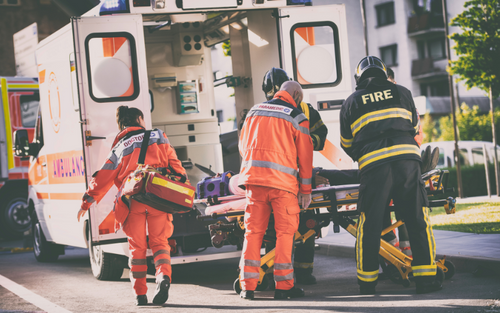EMS Week is May 15-21, 2023
Emergency Medical Services Week is held annually to highlight those who risk their lives by providing care to others. Crews must protect themselves on the job by looking out for biological hazards and preventing slips, trips, and falls. They should also use the proper safety equipment to detect potential hazards as they occur.
The third week of May is National Emergency Medical Services (EMS) Week across the U.S. President Gerald Ford created the week in the 1970s to raise public awareness of EMS and their role in saving lives and providing emergency medical care. EMS workers often put their health in harm’s way when responding to medical emergencies. They provide care to patients in all kinds of locations, such as the person’s home or place of work, some of which can contain a range of hazards—In 2017 alone, there were nearly 90,000 EMS injuries.
EMS workers treat some 22 million patients every year in the U.S. According to the Bureau of Labor Statistics, the injury rate for EMS personnel is about three times the national average for all occupations. The five most common types of injuries among EMS workers are:
- Overexertion and Body Motion
- Exposure to Harmful Substances
- Falls, Slips, Trips, or Loss of Balance
- Motor Vehicle Incidents
- Assaults & Violence
Emergency medical teams and companies must protect EMS workers from these hazards, even though working out in the field can be unpredictable.
Many emergency medical workers report suffering from strains and muscle injuries that can lead to chronic pain. Workers should practice proper lifting techniques when transporting patients to prevent overexertion and unnecessary body movements. They should use stretchers and always lift with their legs to avoid hurting their back.
EMS providers also face various airborne and biological hazards on the job, including blood, vomit, and other bodily fluids that can lead to illness and infection. Providers need to wear personal protective equipment (PPE), including disposable safety gloves and face masks. Workers in an environment with a chemical spill should wear chemical-resistant gloves to avoid burning their skin.
EMS personnel can sometimes respond to cases where hazardous particles and gases are present. For example, carbon monoxide (CO) poisoning is known as the “silent killer” because it is odorless and invisible to the naked eye. Many people use carbon monoxide-producing heaters, generators, and lamps in cold weather and during power outages. Responding to reports of flu-like illness or unconscious citizens may involve CO poisoning, which also poses a risk to the first responders. Portable CO monitors can easily attach to the outside of a jump bag or can be clipped on turnout gear to give EMS an advance warning of this threat. They are lightweight and battery-operated, so they can easily be worn in the field.
Slips, trips, and falls can happen to EMS workers often when rushing to save another person’s life. Changes in the terrain or floor can catch these professionals off guard. Carrying a lot of weight also increases the risk of slipping and falling. Workers should check the location pathways, entrances, and exits for possible slip hazards and adjust their routine accordingly. Wearing slip-resistant shoes also helps workers keep their balance on the job.
Vehicle crashes can also easily occur when EMS vehicles navigate through traffic or rush to the nearest medical facility. Drivers can change the siren tone when crossing intersections to keep other vehicles out of the way. Workers in the patient part of the vehicle may need to move around while the ambulance is moving. Companies should invest in restraints that allow EMS providers to move around in the back, so they can still care for the patient without putting themselves at risk in the event of a crash.
Workplace violence remains common in the healthcare industry, and many EMS workers believe being assaulted is just part of the job. But companies need to take steps to reduce the risk of violence by training staff members in the latest de-escalation techniques, including verbal and nonverbal communication. Workers should also be encouraged to report incidents on the job, so the company can take steps to reduce these incidents from happening in the future.
Emergency Medical Services Week is about honoring the brave men and women who devote their lives to providing healthcare in potentially dangerous situations. The best way to honor them is to keep them safe on the job.
Recent Posts
-
Promoting Safety: National Work Zone Awareness Week is April 15-19, 2024
Each year, the National Work Zone Awareness Week (NWZAW) places the spotlight on the importance o …Apr 11th 2024 -
Understanding 4 Gas Monitors: How They Work & Why They Are Important
In today’s increasingly dynamic industrial landscape, 4 gas monitors have emerged as critical com …Apr 8th 2024 -
April Showers Require Workers to Wear Hi-Vis Safety Rain Gear
While April showers bring May flowers, they also bring challenges, particularly for those working …Apr 1st 2024





